13 Red Flags To Look For When Buying Fruit From The Grocery Store
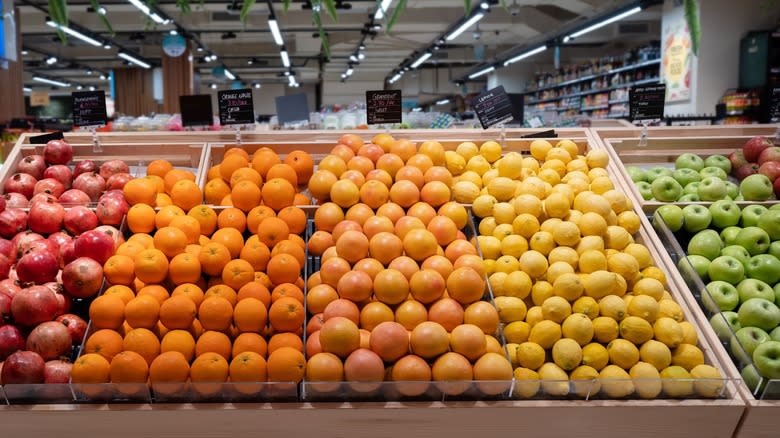
If you've been to the grocery store in the last few days, or weeks, it's highly likely that you picked up some fresh fruit while you were there. Fruit is an essential part of a regular shop, and we spend more on it per year than you might think: In 2022, US households spent, on average, almost 1,100 dollars each on fruit and vegetables, per Statista. That's a lot of money, which provides a lot of opportunity to get things wrong — and unfortunately, you're probably more likely to buy poor-quality fresh fruit than any other item at the store, if you ignore the red flags waving at you from the produce section.
Fresh fruit is uniquely vulnerable to being substandard due to the very thing that makes it so appealing: Its freshness. Because it's unprocessed, there's way more scope for inconsistent quality, which makes being able to spot its red flags so much more crucial. Luckily, for a lot of fruits, the red flags can be fairly similar: You can largely tell whether you should avoid them by looking at their physical appearance, smelling them, or testing their firmness. Because what's normal and what's not can vary from fruit to fruit, though, we decided to line all those red flags up, to show you what you should and shouldn't look for.
Read more: The 6 Best And 6 Worst Grocery Stores To Buy Produce From
Overripe Bananas May Have Loose Stems
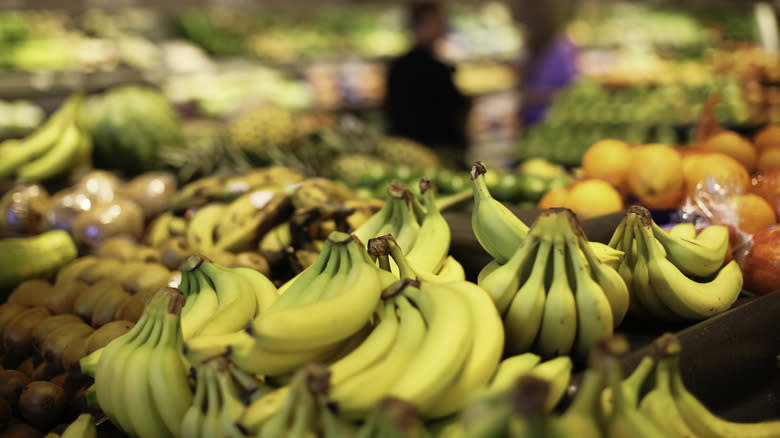
Telling whether a banana is fresh or not by just looking at it can be surprisingly tricky. Between its early stages, when it will have a pale green skin, and its overripe stages, where it will be dappled with brown spots, there's a fairly long period of yellowness — and it can be difficult to know exactly when it's past its prime. If you're looking for a surefire red flag, though, check out your banana's stem. If there's any looseness around the stem, it could be a sign that it's starting to become overripe, and buying it may be a mistake.
A loose stem, or a missing stem, may also cause your banana to ripen more quickly, so if it's not firmly attached, it's best left on the shelf if you want your fruit to last for longer. There's also a stem-related trick you can do to keep your bananas from ripening too fast. Once you get your bananas home, wrap plastic wrap around their stems (you can separate your bananas to do this, provided that you don't rip the stem from the body of the fruit while you do so). This will stop ethylene gas from ripening other parts of the fruit, which can cause it to brown even more.
Gone-Bad Pineapples Could Have Brown Leaves
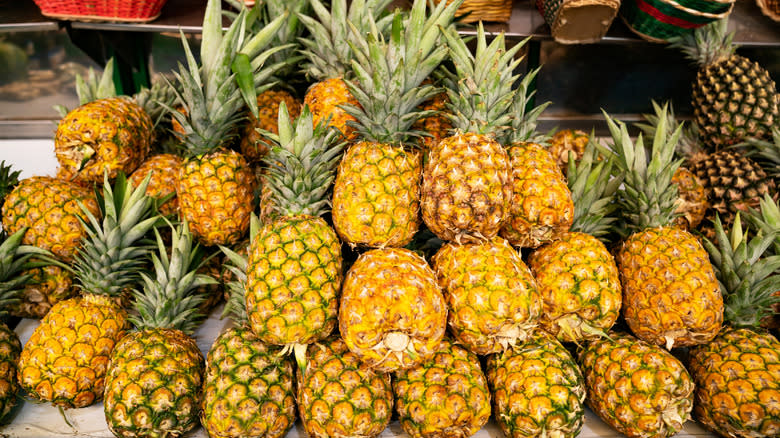
We wouldn't blame you for finding it hard to choose the right pineapple. If you don't buy these fruits very often, it can be somewhat of a mystery. One way to tell for certain that the pineapple you just picked up is not long for this world is by checking out its leaves. When your pineapple is healthy and fresh, it will have green, firm leaves. When it starts to go bad, its leaves will turn from green to brown, and they'll be brittle and dry.
How do you tell, though, when these green leaves are mature enough to indicate fresh fruit? All you need to do is give them a tug. When the fruit is at peak ripeness, the leaves at the center of the fruit should be able to be pulled away with ease. If you're still in-store when trying this, we'd recommend only trying to do this with one leaf — you don't want it to seem like you're damaging the fruit. You should also keep an eye out for a green-yellow skin color and a fresh, sweet smell coming from the pineapple.
Unpackaged Fruit Will Go Bad Faster
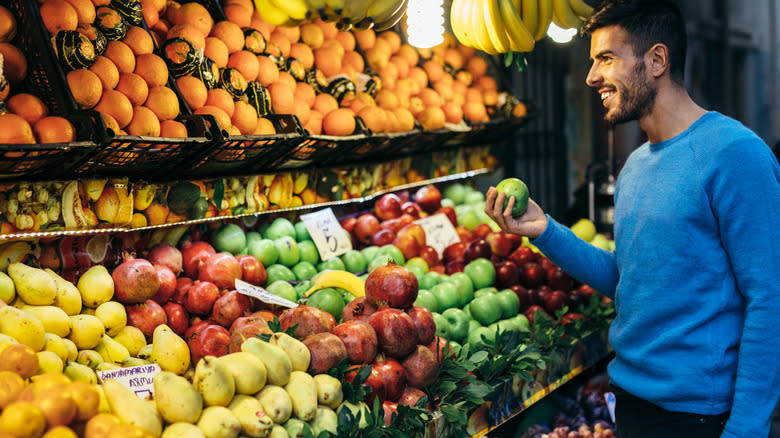
One huge red flag that indicates that your fruit is more susceptible to going bad is if it's unpackaged. We know, we know — surely we're not recommending that you contribute to more packaging waste by buying shrink-wrapped fruit over the loose kind, right? Let us explain. When fruit is unpackaged, it's way more likely to have been handled by multiple people, both on its way to the store and when it's in the store itself. This handling means a higher likelihood of fruit being bruised, bashed, or split, both on the fruit being touched and any fruit underneath it, when it's tossed back into the pile.
Then, when you get that fruit home from the store, it's more likely to go bad quickly. This, in turn, can lead to food wastage and wasted money when you have to toss your fruit out without eating it. While we very much understand the hesitation around buying packaged fruit over unpackaged kinds, opting for produce packaged in fully recyclable materials can be a good way to stay conscious of the environment without ending up with poor-quality food you'll just have to throw out.
Strawberries Sticking To The Bottom Of The Carton May Not Be As Fresh
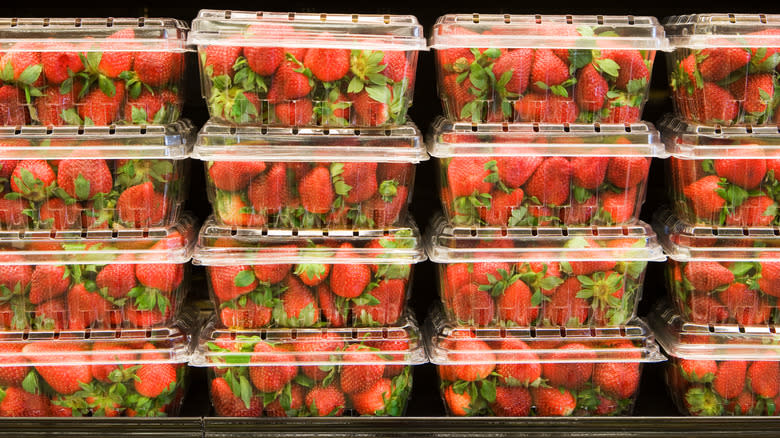
Strawberries can be tricky to buy. These berries are generally prepackaged, which gives you peace of mind that they're not overly handled but which also limits your ability to assess them for their freshness. So when you can't test your strawberries by giving them a squeeze, what can you do? The secret to make sure you always pick up the freshest strawberries is turning the carton over, and checking the pad at the bottom.
This absorbent pad is designed to keep your strawberries dry, and soak up any moisture left over from their washing. If you notice that any of your strawberries are sticking to it, though, or it has strawberry juice in it, it's a quite literal red flag that you should pick another carton. When your strawberries are sticking or leaking juice, they've likely reached a point where they're becoming overripe and soft, or else have been bashed around so much in their processing that they're pretty much spoiled. This increased moisture can also produce mold, which you likely won't want to be contending with while eating your berries.
Lightweight Tomatoes May Be Dry
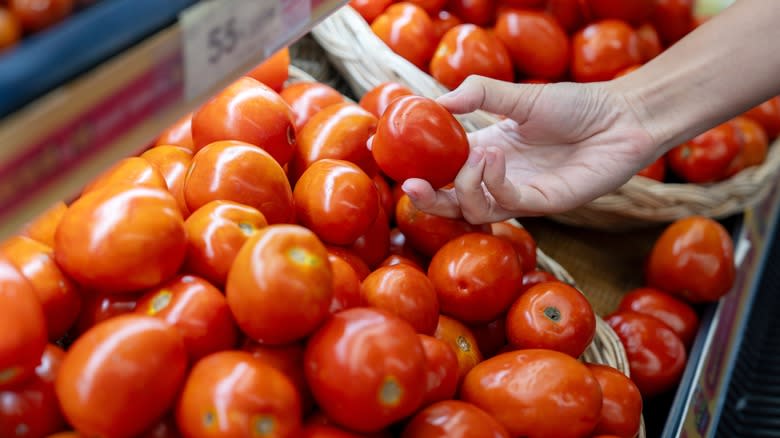
Tomatoes can be surprisingly difficult to assess the freshness of, especially if you're just looking at them. That's why you should get your hands on them. If you pick up your tomatoes and notice that they feel a little light for their size, they may not be ready yet. As tomatoes ripen, they get heavier and release more moisture, while their flesh turns from tough and mealy to tender and juicy.
You should also watch out for tomatoes that feel a little too juicy, though. If your tomato is soft to the touch, that's a clear sign that it's overripe and past its prime. Don't be afraid to get your nose involved, either. Give your tomatoes a smell: If they have a fruity, herbal scent that hits the nose quickly, that's a good sign that they're ready to eat. If they have barely any smell, or none at all, that could indicate that they're not ripe yet. On the other hand, if they smell sour or strange, they could be too ripe and are best avoided.
Fruit At The Top Of The Pile Could Be Closer To Turning Bad
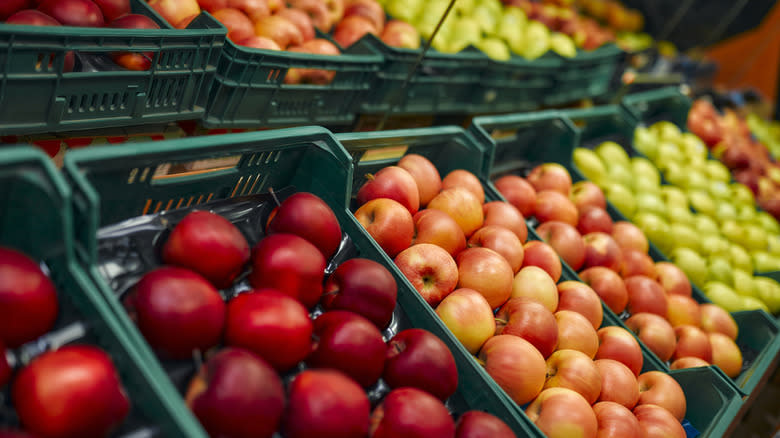
Some red flags only apply to specific fruits — but others apply to all of them. One universal sign that your fruit may be past its best may be revealed by the way your store decides to stack it. Supermarkets have a vested interest in selling as much stock as possible before it goes bad, so when their fruit begins to get closer to perishing, they display it more prominently. This means that, generally speaking, the fruit that's more likely to go bad sooner will be at the top of the pile.
If this fact makes you think that you're doomed to only obtain about-to-perish fruit forever, though, never fear. Many supermarkets will have newer fruit underneath the older produce, waiting to take its place. To get the items that'll last the longest, you just have to look underneath the top box or shelf of fruit, and pick the items below. Be careful as you're doing this: You don't want to spill all of the fresh fruit onto the floor, and nor do you want to over-handle the fruit and risk bruising it for the next customer. It's also worth remembering that the fruit at the top of the pile isn't necessarily completely off-limits, and you may still get a good few days of freshness out of it.
Wrinkled Bell Peppers May Be Past Their Prime
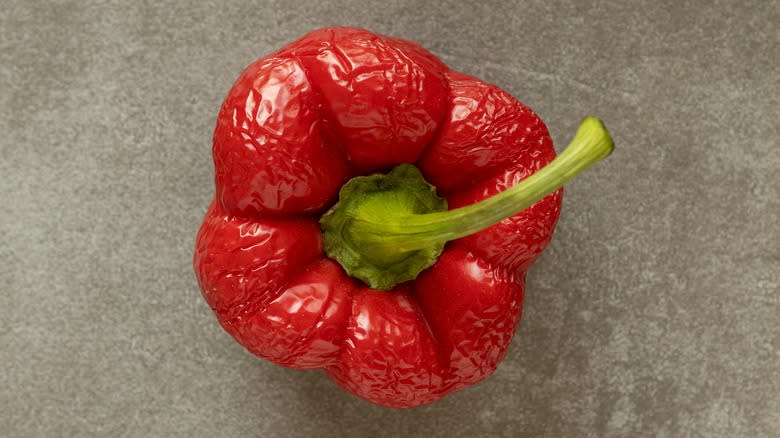
When bell peppers are fresh, they're things of beauty: Shiny, vibrant, luminous fruits that glow at you from the supermarket shelves, promising sharp, crisp flavor within. However, bell peppers can turn from glorious to gloomy pretty quickly, and one of the first signs they're going bad is how their skin looks. When bell peppers are past their best, they'll start to pucker and prune, developing wrinkled skin that begins to pull away from the fruit. This is also usually accompanied by a softer texture.
This skin wrinkling occurs due to lost moisture, which will also reduce their taste and their texture, giving them a dry and mealy mouthfeel. This won't necessarily make them unsafe to eat, and if you need to you can still use them in your meals — they just won't taste as good. Instead, you should be looking for bell peppers that have a taut, smooth appearance and a healthy shine to them. You should also take a look at their stem: When they're at their freshest, it will be verdant-looking and green. The pepper will also feel heavy and firm to the touch.
Gone-Bad Grapes Will Have A Brittle Stem
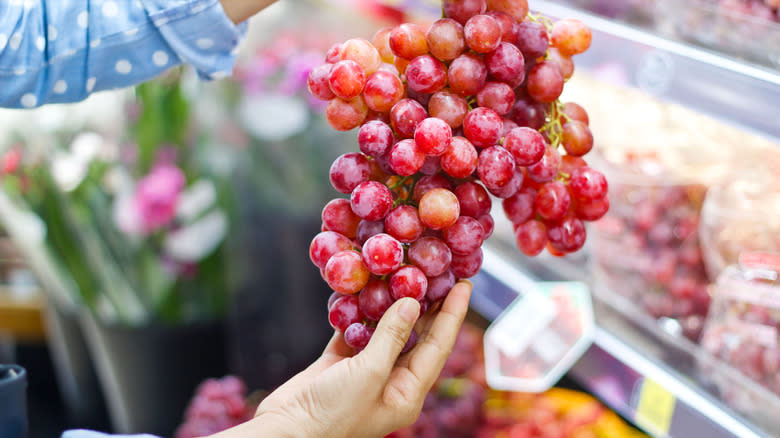
It can be surprisingly tricky to pick good grapes in the supermarket. One common mistake people make when buying them, though, is forgetting that their stems can tell you a huge amount about how fresh they are. Healthy, juicy grapes will usually be accompanied by a healthy-looking green stem. The stems will also have a good amount of bend in them, and be securely attached to each grape, while still allowing you to pull the fruits away easily.
By contrast, gone-bad grapes will have stems that look pretty unhealthy. The stems will be brown and dry-looking, and will snap easily. Your fruit will also be pulling away from the stems — not just because it's trying to escape the sickly-looking twigs, but because there's no longer any moisture in them that can keep them plump. It's not just the stems that will look a little worse for wear if your grapes are beyond hope, either: The fruits themselves will begin to pucker and shrivel, looking juiceless and unappetizing. They'll also have an overly-soft texture, and a sour, unpleasant flavor.
Apples With Unpleasant Smells Aren't As Fresh
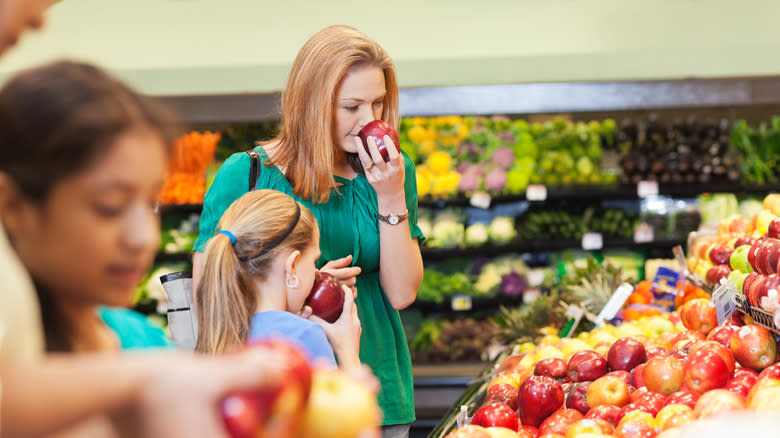
Figuring out whether an apple will be crisp and juicy is surprisingly tricky: The best-looking apples may still conceal a dry, pappy flesh that has no flavor whatsoever, and even apples that have some marks on them can be fresh and tasty. That's why you should use your nose. One of the biggest red flags when it comes to apples isn't visual, but nasal, and is revealed by them having an unpleasant smell. If the apple you've just picked up has any hint of vinegariness on the nose, it's a clear indication that it'll taste bad too.
Ripe, ready-to-eat apples, by contrast, will have a gently fragrant, sweet smell. It's worth remembering that the specific smell will vary depending on the variety you're going for, with some being more fragrant than others, but a good rule of thumb to follow is that if it smells nice, it'll probably taste quite nice. If you can, try to assess the apple's firmness, too. Good-quality apples will feel taut without being hard, and won't yield to you squeezing them — unlike past-their-prime apples, which will be soft.
Overripe Peaches Will Be Soft And Squishy
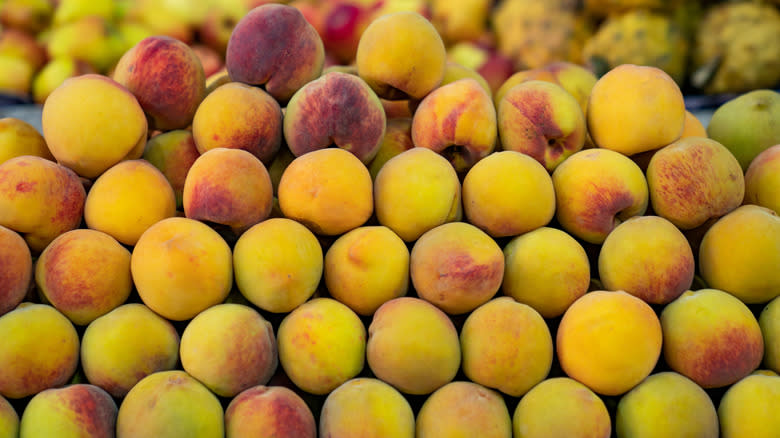
Getting the right peach can be a pretty delicate balance. Like other stone fruits, you want your peaches to be juicy, but not jammy; plump and firm, but not hard. This can be tricky to figure out by just looking at the peach itself, which is why you have to pick them up and feel them. If your peaches feel overly soft, or like you can break their skin by simply squeezing them, it's a big red flag that indicates that they've ripened too much. The fruit inside will be pulpy and sloppy, and will have none of that fresh taste that makes peaches so moreish.
Ideally, you'll want to look for peaches that have a little bit of give when you squeeze them. Exactly how much give can be pretty subjective, but if it feels too firm, or only gives a tiny amount, it may need a bit more ripening. Bear in mind, however, that peaches will continue to ripen at home, so if you buy them when they're still not at their best, that's not necessarily a bad thing (unless you want to eat them immediately, that is). To ripen them properly, keep them away from direct sunlight in a cool, dry place.
Inconsistent Colors In Blueberries Are A Red Flag
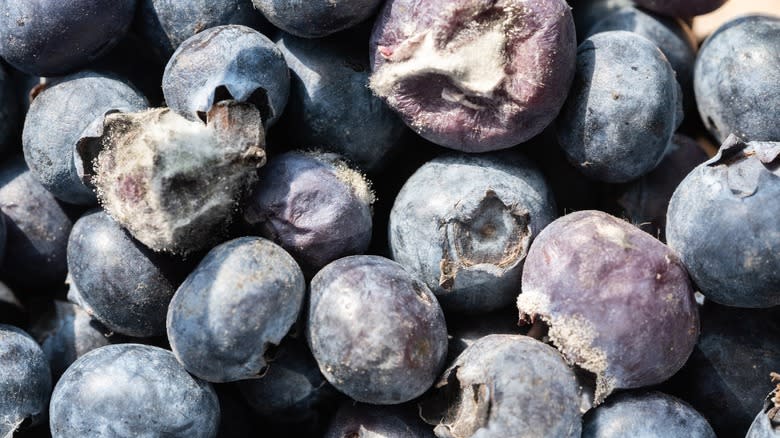
This will probably come as no surprise, but blueberries are kinda best when they're, y'know, blue. So if your tray of blueberries has any other colors in it, that's a huge red flag (although we're hoping there's no red in that tray, otherwise you should run for the hills). While this might sound uncommon, it's more likely than you think. Because blueberries are so small, in commercial operations they're generally picked and processed using large-scale methods instead of by hand, and although some outfits use optical sorters to sift out green or white blueberries, these can still make it out of the factory and into your kitchen.
These green or white berries were picked before they had a chance to fully ripen, and once they're plucked from the plant, they'll remain that way — and have a pretty poor flavor. So, to make sure you have the best blueberries, look for a consistent blue-purple color across all of the berries. They should also look smooth and healthy across all their skins, with no signs of damage. Finally, your berries should have a plump, healthy appearance, promising juiciness in every bite.
Oranges Without Any Weight To Them Are Best Avoided
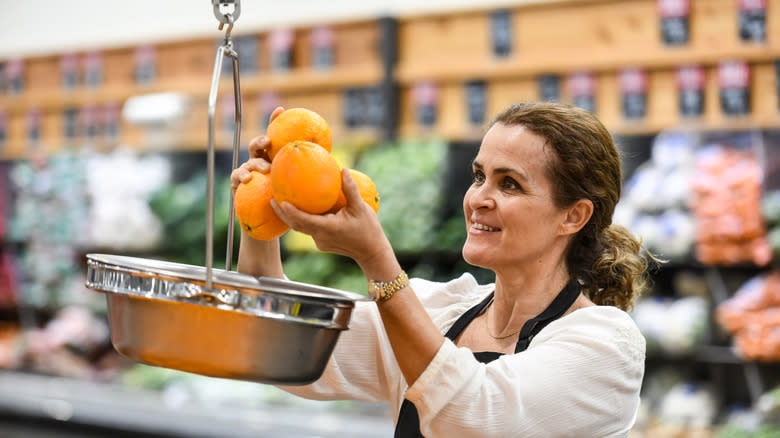
There's one big problem with buying oranges: Their skins. Orange skins serve to protect the tender segments inside, but they also prevent us from getting a good sense of how juicy our orange actually is. Then, we tear into it, take a bite, and find that it's desiccated and unappealing.
How do you avoid this? You've gotta pick them up, folks. Picking out deliciously ripe and juicy oranges starts with assessing their weight, relative to their size. If your orange feels heavy, it's a good sign that it's got plenty of juice inside. On the other hand, if it feels light, it may be an indication that it's lost a good amount of moisture already, which can continue to happen after the fruit has been harvested.
As with other fruits, you should also check out how your orange smells. Fresh, ripe oranges will have a fresh, ripe orange smell — that classic citrusy scent that we associate with the fruit. Under-ripe or overripe oranges will have a different smell altogether, and won't be as enticingly fragrant.
Cherries That Feel Hard To The Touch Aren't Ready
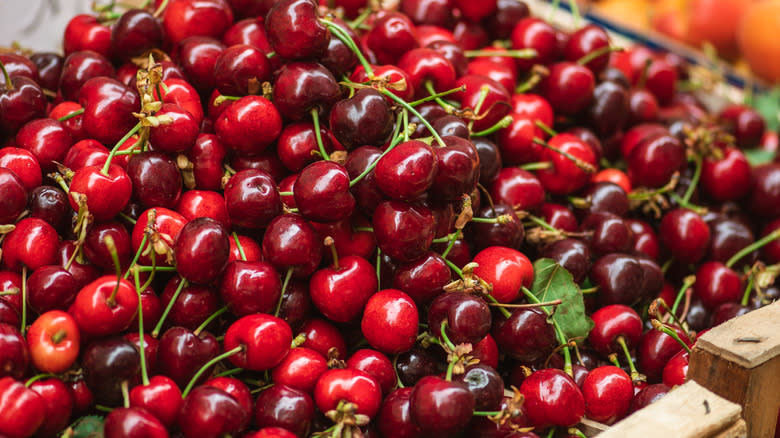
Ah, cherries. So delicious when they're ripe, so sour and unpleasant when they're not. If you don't buy cherries on a regular basis, it can be hard to know where that sweet spot sits — and one common mistake when buying cherries is forgetting to pick them up. Unripe cherries will have a hard feel that may not be immediately clear by just looking at them. These won't yield whatsoever when you squeeze them lightly. Biting into them will achieve much the same effect: You'll get none of the juicy sweetness that you expect, and instead be faced with a hard, vegetal texture and a sour flavor.
Importantly, though, things shouldn't go too far in the other direction. If your cherries feel overly soft or yield too much to you squeezing them, they're overripe, and will be mushy to the bite. They'll also start to turn from sweet to slightly vinegary. You want a good middle ground here: Cherries that have a slight give to them, promising juiciness within, but which don't bruise upon being handled.
Read the original article on The Daily Meal.

 Yahoo Lifestyle
Yahoo Lifestyle 
